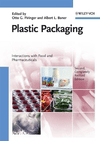Industry Q&A
Sealed Air and Plastic Energy Announce Partnership

Flexible Packaging spoke with Ron Cotterman, VP of Sealed Air’s sustainability and innovation, to discuss the company’s partnership with Plastic Energy and how it can impact sustainability in the flexible packaging industry.
The interview has been edited for clarity.
Would you tell us more about Sealed Air and the recent partnership with Plastic Energy?
Sealed Air, a global materials and solutions provider, creates innovative packaging solutions that protect food, consumer goods, medical supplies and industrial products. In August 2020 we announced an equity investment and collaboration agreement with Plastic Energy, a company that specializes in advanced recycling technology. Plastic Energy’s goal is to create a circular economy for plastics by diverting plastic waste away from landfills and oceans. This collaboration is a significant step in a journey that is expected to transform how packaging is viewed and to create opportunities to eliminate waste. We intend to play a leadership role in this space.
How does the partnership move the needle toward a circular economy with regard to plastic?
Essentially, this collaboration will prove that flexible plastic can be recycled using advanced recycling technology into new plastic with properties identical to those of virgin materials. As a result, these recycled plastics can be used to create essential packaging solutions, including ones that Sealed Air makes — like protective packaging for food. Doing this keeps flexible plastic moving through a closed loop, instead of ending up in a landfill or the environment. Additionally, the use of thin, flexible packaging means less material than rigid or semi-rigid plastics.
How does the recent partnership with Plastic Energy advance Sealed Air’s sustainability and plastics pledge?
Plastic Energy’s circular economy for plastics goal aligns nicely with Sealed Air’s sustainability and plastics pledge. To achieve this pledge, we are designing our innovative packaging solutions to be 100% recyclable and to contain 50% recycled content in addition to accelerating the innovation and development of end-to-end solutions. Another element to our pledge is collaborating with partners (like Plastic Energy) to increase recycling and reuse rates and to eliminate waste. This collaboration is important to our sustainability and plastics pledge because the two companies will be able to demonstrate the commercial and technical viability of circular loops for flexible plastic packaging. We will combine our expertise in plastics, packaging design and recycling technology with our supply chain collaborators, to demonstrate beneficial outcomes that meet economic, environmental and societal needs.
What types of plastic(s) serve as the feedstock to be recycled into other products for your process? Are you able to use previously recycled plastics?
The idea is that advanced recycling allows the same plastic to be recycled and used over and over again; we refer to this as a closed loop and it means that ideally, plastic never leaves the loop or ends up in a landfill or in the environment. Comparing this to traditional mechanical recycling, where each time a material gets recycled it gets degraded somewhat, advanced recycling offers significant advantages. The more plastic that is recycled this way means less production of virgin material will be required. In order to accomplish the promise that advanced recycling enables, investments need to be made to increase the infrastructure to recover, process and recycle flexible plastic. We are already seeing major companies begin this investment process with many active projects now underway.
What are your sources for the feedstock?
The technology used by Plastic Energy relies on pyrolysis. Polyolefins are an ideal feedstock for that process, especially polyethylene and polypropylene. Since flexible plastics rely extensively on polyolefins, they make an ideal feedstock. We are leading efforts within our industry to align the design of multi-layer flexible plastics with the requirements of the pyrolysis process, to enable a wide range of feedstock options, including household and industrial flexible plastics.
What industry(ies) are the plastics made from this process qualified for?
Plastics recycled through this advanced recycling process match the properties of virgin resins. First, advanced recycled resins will meet the rigorous food safety requirements needed in order to be used to package food. Food packaging needs complex, multi-layer flexible plastic in order to extend shelf life and ensure freshness (which ultimately leads to less food waste and a lower carbon footprint overall). Second, advanced recycled resins can be used in e-commerce and industrial applications where the use of thin, lightweight packaging reduces total packaging weight, resulting in lower impacts and significant source reduction. Overall, all the benefits achieved with thin, lightweight flexible packaging can be achieved with advanced recycled plastics.
Is there anything else you’d like to add?
Sealed Air and Plastic Energy already have projects underway that explore the opportunities and limits of flexible plastic packaging as a feedstock to advanced recycling. In September, Tesco announced it would be selling cheese made from flexible packaging that was returned to store drop-off bins by customers. Both Sealed Air and Plastic Energy were two of the companies involved in this closed loop pilot project.
For more information, visit plasticenergy.com.
Looking for a reprint of this article?
From high-res PDFs to custom plaques, order your copy today!









